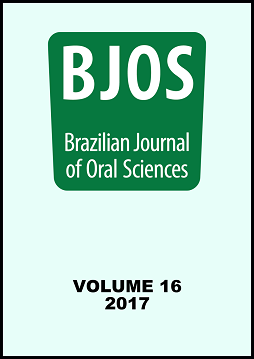Abstract
Microscopic measurements are widely used in scientific research and the correct equipment to realize these evaluations could be critical to determine study results. Regarding microscopic measurements, three of the most used methods are: Optical Microscopy (OM), Scanning Electron Microscopy (SEM), and Micro-computed Tomography (MCT). It is important to select the best method for assessing diverse parameters, considering operational characteristics of the method, the equipment efficiency, and the machinery cost. Therefore, the main objective of this study was to define which is the most useful measurement method for assessing magnitudes below 0.4 mm. Ten dental implants, with known dimensions as defined by the manufacturer were randomly distributed. Two blinded observers assessed the distance between the second and the third screw vortex of the implants using three suggested methods. The true distance was defined to be 0.5 mm. The assessed distances were: 0.597±0.007mm for OM, 0.578±0.017mm for SEM, and 0.613±0.006mm for MCT. The assessed distances were significantly different when the methods were compared (P>0.01). All measurements were into the CAD tolerances. It was possible to conclude that linear measurements between 595 and 605 μm could be performed by any of the described technologies.References
Chatburn RL. Evaluation of instrument error and method agreement. AANA J. 1996 Jun;64(3):261-8.
Ludbrook J. Statistical techniques for comparing measurers and methods of measurement: a critical review. Clin Exp Pharmacol Physiol. 2002 Jul;29(7):527-36.
Landis JB, Ventura KL, Soltis DE, Soltis PS, Oppenheimer DG. Optical Sectioning and 3D reconstructions as an alternative to scanning electron microscopy for analysis of cell shape. Appl Plant Sci. 2015 Apr 3;3(4). pii: apps.1400112. doi: 10.3732/apps.1400112.
Karras DJ. Statistical methodology: II. Reliability and validity assessment in study design, Part B. Acad Emerg Med. 1997 Feb;4(2):144-7.
Watson PF, Petrie A. Method agreement analysis: a review of correct methodology. Theriogenology. 2010 Jun;73(9):1167-79. doi: 10.1016/j.theriogenology.2010.01.003.
White SA, van den Broek NR. Methods for assessing reliability and validity for a measurement tool: a case study and critique using the WHO haemoglobin colour scale. Stat Med. 2004 May 30;23(10):1603-19.
Edwards R. Two-dimensional convolute integers for analytical instrumentation. Anal Chem. 1982;54:1519-24.
Shaw DE, Jones HS, Moseley MJ. Analysis of method-comparison data. Ophthalmic Physiol Opt. 1994 Jan;14(1):92-6.
Gaviria L, Salcido JP, Guda T, Ong JL. Current trends in dental implants. J Korean Assoc Oral Maxillofac Surg. 2014 Apr;40(2):50-60. doi: 10.5125/jkaoms.2014.40.2.50.
Tomsia AP, Launey ME, Lee JS, Mankani MH, Wegst UGK, Saiz E. Nanotechnology approaches for better dental implants. Int J Oral Maxillofac Implants. 2011;26:25-49.
Brånemark P-I, Zarb GA, Albrektsson T. Tissue-integrated prostheses. Chicago: Quintessence; 1985. 352 p.
Faria KO, Silveira-Junior CD, Silva-Neto JP, Mattos MGC, Silva MR, Neves FD. Comparison of methods to evaluate implant-abutment interface. Braz J Oral Sci. 2013;12(1):37-40.
Coelho PG, Jimbo R. Osseointegration of metallic devices: current trends based on implant hardware design Arch Biochem Biophys. 2014 Nov 1;561:99-108. doi: 10.1016/j.abb.2014.06.033.
Hecker DM, Eckert SE. Cyclic loading of implant-supported prostheses: changes in component fit over time. J Prosthet Dent. 2003 Apr;89(4):346-51.
Hultin M, Komiyama A, Klinge B. Supportive therapy and the longevity of dental implants: a systematic review of the literature. Clin Oral Implants Res. 2007 Jun;18 Suppl 3:50-62.
Neves FD, Elias GA, Silva-Neto JP, Dantas LCM, Mota AS, Neto AJF. Comparison of implant-abutment interface misfits after casting and soldering procedures. J Oral Implantol. 2014 Apr;40(2):129-35. doi: 10.1563/AAID-JOI-D-11-00070.
Finelle G, Papadimitriou DE, Souza AB, Katebi N, Galucci GO, Araújo MG. Peri-implant soft tissue and marginal bone adaptation on implant with non-matching healing abutments: micro-CT analysis. Clin Oral Implants Res. 2015 Apr;26(4):e42-6. doi: 10.1111/clr.12328.
Gomes RS, Souza CMC, Bergamo ETP, Bordin D, Del Bel Cury AA. Misfit and fracture load of implant-supported monolithic crowns in zirconia-reinforced lithium silicate. J Appl Oral Sci. 2017 May-Jun;25(3):282-289. doi: 10.1590/1678-7757-2016-0233.
Neves FD, Prado CJ, Prudente MS, Carneiro TA, Zancope K, Davi LR, et al. Microcomputed tomography marginal fit evaluation of computer-aided design/computer-aided manufacturing crowns with different methods of virtual model acquisition. Gen Dent. 2015 May-Jun;63(3):39-42.
Prudente MS, Davi LR, Nabbout KO, Prado CJ, Pereira LM, Zancopé K, et al. Influence of scanner, powder application, and adjustments on CAD-CAM crown misfit. J Prosthet Dent. 2017 Jul 7. pii: S0022-3913(17)30280-9. doi: 10.1016/j.prosdent.2017.03.024.
M. Kurz, T. Attin, A. Mehl Influence of material surface on the scanning error of a powder-free 3D measuring system. Clin Oral Investig. 2015 Nov;19(8):2035-43. doi: 10.1007/s00784-015-1440-5.
L. Jahangiri, D. Estafan A method of verifying and improving internal fit of all-ceramic restorations. J Prosthet Dent. 2006 Jan;95(1):82-3.
Katsoulis J, Merickse-Stern R, Rotkina L, Zbären C, Enkling N, Blatz MB. Precision of fit of implant supported screw-retained 10-unit computer-aided-designed and computer-aided-manufactured frameworks made from zirconium dioxide and titanium: an in vitro study. Clin Oral Implants Res. 2014 Feb;25(2):165-74. doi: 10.1111/clr.12039.
Jin P, Li X. Correction of image drift and distortion in a scanning electron microscopy. J Microsc. 2015 Dec;260(3):268-80. doi: 10.1111/jmi.12293.
Groten M, Axmann D, Pröbster L, Weber H. Determination of the minimum number of marginal gap measurements required for practical in-vitro testing. J Prosthet Dent. 2000 Jan;83(1):40-9.
Kline TL, Zamir M, Ritman EL. Accuracy of microvascular measurements obtained from micro-CT images. Ann Biomed Eng. 2010 Sep;38(9):2851-64. doi: 10.1007/s10439-010-0058-7.
Mangione F, Meleo D, Talocco M, Pecci R, Pacifici L, Bedini R. Comparative evaluation of the accuracy of linear measurements between cone beam computed tomography and 3D microtomography. Ann Ist Super Sanita. 2013;49(3):261-5.DOI: 10.4415/ANN_13_03_05.
Özkan G, Kanli A, Başeren NM, Arslan U, Tatar I. Validation of micro-computed tomography for occlusal caries detection: an in vitro study. Braz Oral Res. 2015;29(1):S1806-83242015000100309. doi: 10.1590/1807-3107BOR-2015.vol29.0132.
Grande NM, Plotino G, Gambarini G, Testarelli L, D’Ambrosio F, Pecci R, et al. Present and future in the use of micro-CT scanner 3D analysis for the study of dental and root canal morphology. Ann Ist Super Sanita. 2012;48(1):26-34.DOI: 10.4415/ANN_12_01_05.
The Brazilian Journal of Oral Sciences uses the Creative Commons license (CC), thus preserving the integrity of the articles in an open access environment.

